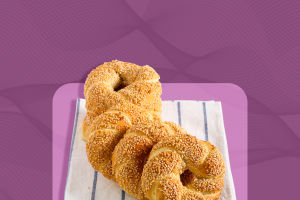Pita is a unique bread staple, originating in the Middle East and the Mediterranean region, where it has the same status as steamed buns in northern China. It is interesting to see how the flat dough puffs up like an angry puffer fish, forming a large, round 'belly' and eventually a hollow pastry.
The pastry is cut open to resemble a large pocket, hence the name 'pocket bread'. Although pita bread is traditionally eaten with a sauce, more people like to use this 'pocket' to fill it with a variety of fillings that they never get tired of eating. Pita is very easy to make, no oven required, so it's perfect to make at home. Stuff the pita with the filling and bite into it for a bite of happiness.
Traditionally pita is eaten with a sauce made from olive oil or chickpeas, but we don't have to be so rigid about what we put in it - fish, vegetables, eggs, etc. We put whatever we want in our pita. No matter what we put in our pita, it's more than addictive and pita is really good for breakfast. The pita can be made in a round shape, which is very similar to a loaf.
The pita is very easy to make, the same process as making regular bread, but without the need to knead a glove film, which is easier than making bread, even if you don't have high-gluten flour at home, you can still make it with regular flour. If you're still busy cooking onion pancakes, why not try this one, which is lower in oil and healthier?
Ingredients for pita bread:
200g high-gluten flour (bread flour)
5g sugar
1g salt
2g low sugar-resistant (regular) yeast
130g warm water
10g wheat flour
5g vegetable oil
1: Put all the ingredients of the flour into a bowl, put 2 spoons of wheat flour into the bowl, but leave it out. Of course, you can make other flavors, like pumpkin, purple potato, carrot, etc.
2: Melt the yeast in warm water, pour it into the flour and form a dough.
3: Transfer the dough to a board and knead it smoothly, add the vegetable oil and continue kneading.
4: Knead the dough and put it in a large bowl in a warm place to ferment, cover the container with a lid to moisturize.
5: The dough should be at least 2 times its original size when fermented.
6: Transfer the dough to a board and divide it into 4 equal portions without kneading.
7: Roll the dough up and down, it may shrink when you roll it out, so don't continue rolling it out, cover it with plastic wrap and continue to relax for 10 minutes before rolling it out. Cover with plastic wrap and let the dough rise for about 20 minutes, at least to make it look a little fluffy.
8: Preheat the oven to 250°C on the upper heat and 200°C on the lower heat. Place the baking sheet in the lower middle of the oven and bake for 5 to 8 minutes. Remove when the dough has puffed up and the top is colored.
To bake the pocket loaf at a high temperature, preheat the oven by placing the baking tray together with the dough on a hot baking tray and baking it immediately in the oven.
This will allow the pocket loaf to puff up better. Pocket loaves are soft when cooled, if they are crumbly when cooled, they have been baking too long. You can make more pocket loaves at a time, freeze or chill them in the fridge and warm them in the oven for a few minutes when ready to eat.


